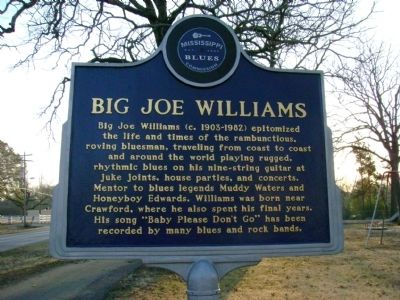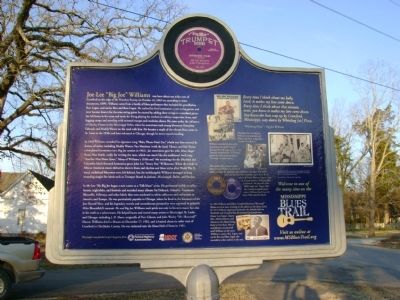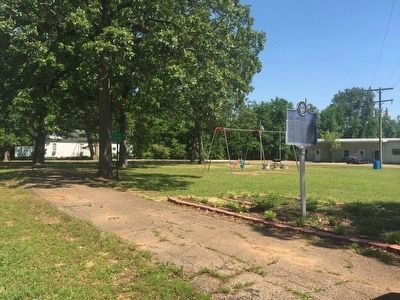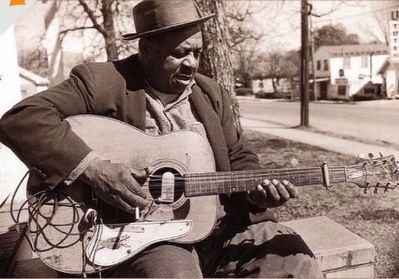Crawford in Lowndes County, Mississippi — The American South (East South Central)
Big Joe Williams
Side A
Big Joe Williams (c. 1903-1982) epitomized the life and times of the rambunctious, roving bluesman, traveling from coast to coast and around the world playing rugged, rhythmic blues on his nine-string guitar at juke joints, house parties, and concerts. Mentor to blues legends Muddy Waters and Honeyboy Edwards, Williams was born near Crawford, where he also spent his final years. His song “Baby Please Don't Go” has been recorded by many blues and rock bands.
Side B
Lee “Big Joe” Williams was born about ten miles west of Crawford on the edge of the Noxubee Swamp on October 16, 1903 (or, according to some documents, 1899). Williams came from a family of blues performers that included his grandfather, Bert Logan, and uncles Bert and Russ Logan. He crafted his first instrument, a one-string guitar, and later became known for the nine-string guitar he created by adding three strings to a standard guitar. Joe left home in his teens and made his living playing for workers at railway, turpentine, levee, and logging camps and traveling with minstrel troupes and medicine shows. He came under the influence of Charley Patton in the Mississippi Delta, where he sometimes took young bluesmen Honeyboy Edwards and Muddy Waters on the road with him. He became a staple of the vibrant blues scene in St. Louis in the 1930s and later relocated to Chicago, though he never ceased traveling.
In 1935 Williams recorded his signature song “Baby Please Don’t Go,” which was later covered by dozens of artists including Muddy Waters, Van Morrison (with the band Them), and Bob Dylan (who played harmonica on a Big Joe session in 1962). Joe sometimes gave his wife, blues singer Bessie Mae Smith, credit for writing the tune, which was much like the traditional work song “Another Man Done Gone.” Many of Williams's 1930s and '40s recordings for the Bluebird and Columbia labels featured harmonica great John Lee “Sonny Boy” Williamson. When the trends in African American music shifted to electric blues and rhythm and blues styles after World War II, many traditional bluesmen were left behind, but the indefatigable Williams managed to keep recording singles for labels such as Trumpet (based in Jackson, Mississippi), Bullet, and Vee-Jay.
In the late '50s Big Joe began a new career as a “folk blues” artist. He performed widely at coffeehouses, nightclubs, and festivals and recorded many albums for Delmark, Arhoolie, Testament, Bluesville, Folkways, and other labels that were marketed to white collectors and enthusiasts in America and Europe. He was particularly popular in Chicago, where he lived in the basement of the Jazz Record Mart, and his legendary travels and cantankerous personality were captured in guitarist Mike Bloomfield’s memoir Me and Big Joe. Williams took pride not only in his own music but also in his work as a talent scout. He helped locate and record many artists in Mississippi, St. Louis, and Chicago, including J. D. Short, originally of Port Gibson, and John Wesley “Mr. Shortstuff” Macon. Williams died in Macon on December 17, 1982, and is buried about six miles west of Crawford in Oktibbeha County. He was inducted into the Blues Hall of Fame in 1992.
Erected 2008 by the Mississippi Blues Commission. (Marker Number 56.)
Topics and series. This historical marker is listed in these topic lists: African Americans • Arts, Letters, Music • Entertainment. In addition, it is included in the Mississippi Blues Trail series list. A significant historical month for this entry is October 1825.
Location. 33° 18.091′ N, 88° 37.302′ W. Marker is in Crawford, Mississippi, in Lowndes County. Marker is on Main Street, 0 miles east of Seitz Road, on the left when traveling west. Touch for map. Marker is in this post office area: Crawford MS 39743, United States of America. Touch for directions.
Other nearby markers. At least 8 other markers are within 8 miles of this marker, measured as the crow flies. B.L. Moor High School (approx. 5.7 miles away); Bethel Presbyterian Church (approx. 6.8 miles away); Dennis Wicks, Jr. (approx. 7.4 miles away); Zacharias Wicks, Sr. (approx. 7.4 miles away); James “Jim” Wicks (approx. 7.4 miles away); Sally Wicks Sharp (approx. 7.4 miles away); Ned Wicks (approx. 7.4 miles away); Wicks Community (approx. 7.6 miles away).
Also see . . . Big Joe Williams playing and singing Baby Please Don't Go. (Submitted on March 1, 2010, by Bill Pfingsten of Bel Air, Maryland.)
Credits. This page was last revised on August 30, 2017. It was originally submitted on February 20, 2010, by Davis Darryl Hartness of Columbus, Mississippi. This page has been viewed 1,147 times since then and 24 times this year. Photos: 1, 2. submitted on February 20, 2010, by Davis Darryl Hartness of Columbus, Mississippi. 3, 4. submitted on May 7, 2016, by Robert M. Cook, Jr. of Biloxi, Mississippi. • Bill Pfingsten was the editor who published this page.



